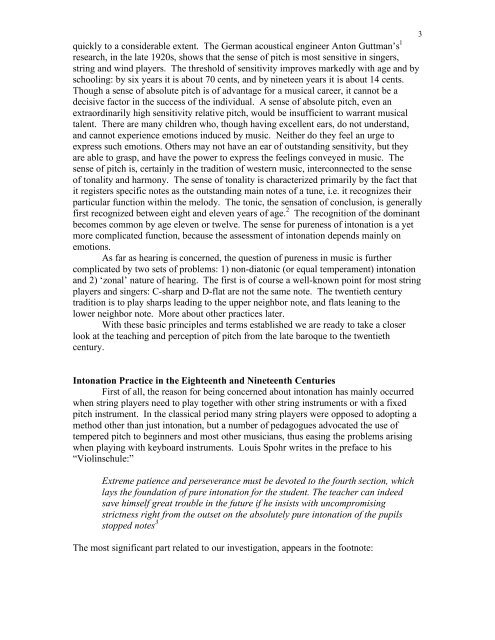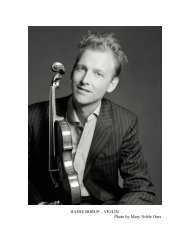A History of String Intonation - Borup, Hasse
A History of String Intonation - Borup, Hasse
A History of String Intonation - Borup, Hasse
You also want an ePaper? Increase the reach of your titles
YUMPU automatically turns print PDFs into web optimized ePapers that Google loves.
quickly to a considerable extent. The German acoustical engineer Anton Guttman’s 1<br />
research, in the late 1920s, shows that the sense <strong>of</strong> pitch is most sensitive in singers,<br />
string and wind players. The threshold <strong>of</strong> sensitivity improves markedly with age and by<br />
schooling: by six years it is about 70 cents, and by nineteen years it is about 14 cents.<br />
Though a sense <strong>of</strong> absolute pitch is <strong>of</strong> advantage for a musical career, it cannot be a<br />
decisive factor in the success <strong>of</strong> the individual. A sense <strong>of</strong> absolute pitch, even an<br />
extraordinarily high sensitivity relative pitch, would be insufficient to warrant musical<br />
talent. There are many children who, though having excellent ears, do not understand,<br />
and cannot experience emotions induced by music. Neither do they feel an urge to<br />
express such emotions. Others may not have an ear <strong>of</strong> outstanding sensitivity, but they<br />
are able to grasp, and have the power to express the feelings conveyed in music. The<br />
sense <strong>of</strong> pitch is, certainly in the tradition <strong>of</strong> western music, interconnected to the sense<br />
<strong>of</strong> tonality and harmony. The sense <strong>of</strong> tonality is characterized primarily by the fact that<br />
it registers specific notes as the outstanding main notes <strong>of</strong> a tune, i.e. it recognizes their<br />
particular function within the melody. The tonic, the sensation <strong>of</strong> conclusion, is generally<br />
first recognized between eight and eleven years <strong>of</strong> age. 2 The recognition <strong>of</strong> the dominant<br />
becomes common by age eleven or twelve. The sense for pureness <strong>of</strong> intonation is a yet<br />
more complicated function, because the assessment <strong>of</strong> intonation depends mainly on<br />
emotions.<br />
As far as hearing is concerned, the question <strong>of</strong> pureness in music is further<br />
complicated by two sets <strong>of</strong> problems: 1) non-diatonic (or equal temperament) intonation<br />
and 2) ‘zonal’ nature <strong>of</strong> hearing. The first is <strong>of</strong> course a well-known point for most string<br />
players and singers: C-sharp and D-flat are not the same note. The twentieth century<br />
tradition is to play sharps leading to the upper neighbor note, and flats leaning to the<br />
lower neighbor note. More about other practices later.<br />
With these basic principles and terms established we are ready to take a closer<br />
look at the teaching and perception <strong>of</strong> pitch from the late baroque to the twentieth<br />
century.<br />
<strong>Intonation</strong> Practice in the Eighteenth and Nineteenth Centuries<br />
First <strong>of</strong> all, the reason for being concerned about intonation has mainly occurred<br />
when string players need to play together with other string instruments or with a fixed<br />
pitch instrument. In the classical period many string players were opposed to adopting a<br />
method other than just intonation, but a number <strong>of</strong> pedagogues advocated the use <strong>of</strong><br />
tempered pitch to beginners and most other musicians, thus easing the problems arising<br />
when playing with keyboard instruments. Louis Spohr writes in the preface to his<br />
“Violinschule:”<br />
Extreme patience and perseverance must be devoted to the fourth section, which<br />
lays the foundation <strong>of</strong> pure intonation for the student. The teacher can indeed<br />
save himself great trouble in the future if he insists with uncompromising<br />
strictness right from the outset on the absolutely pure intonation <strong>of</strong> the pupils<br />
stopped notes 3<br />
The most significant part related to our investigation, appears in the footnote:<br />
3



